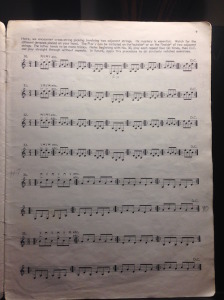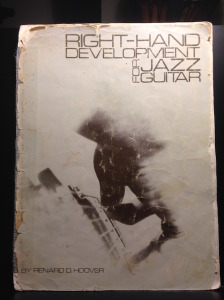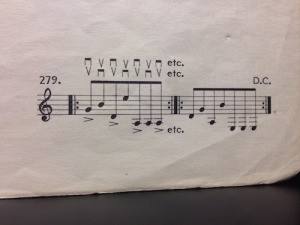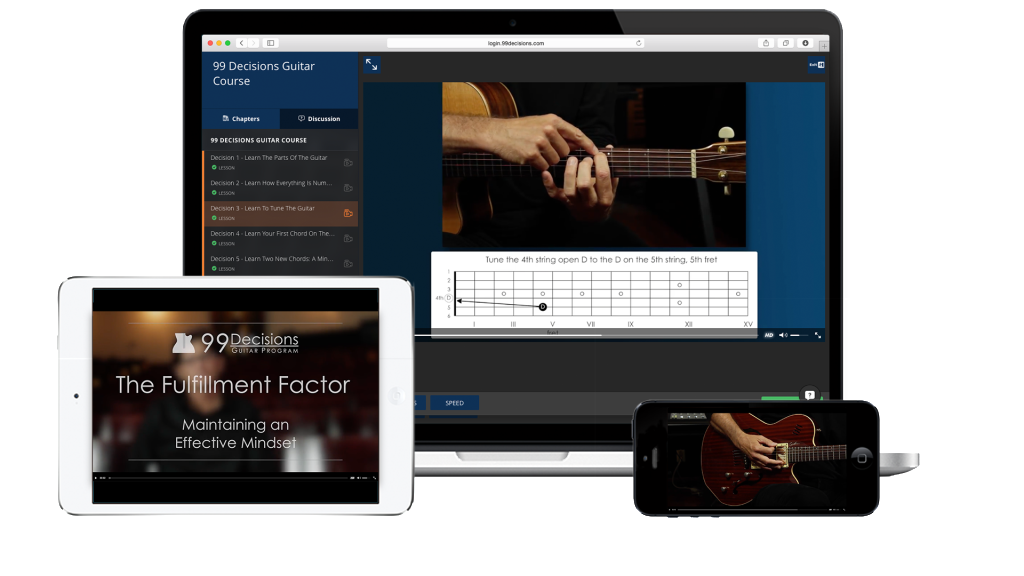I have a whole book of 279 picking exercises for the right hand only… all open strings.
It’s called, “Right Hand Development for Jazz Guitar”, by Renard D. Hoover.
It appears to be out of print & I cannot find any reference to Renard on the entire internet!
(although a guy in Belgium mentioned it in a post once).
Renard did two things with this book.
One, he created an awesome book of exercises that start basic & get very challenging. It has been integral in my technique development since 1980.
Two, he totally blew it when it came to choosing the title, because these exercises would be a great way to develop your right hand picking technique no matter what style of music you play!
He should of at least called it, “Right Hand Development for Shredding Guitar”, and have a picture of a metal dude on the cover tearin’ up the fretboard with his foot on the monitor, while heavy metal chicks in bikinis surrounded him.
I am totally kidding!!! That would be sexist & I would never condone such an approach to marketing an instructional book. I am really just making fun of the metal world.
Which, as it turns, is actually far more risky than upsetting every female who reads that.
Sorry, Zakk Wylde.
Anyways… what was I saying? Oh yeah, right hand picking…
When you are picking adjacent pairs of strings, it’s sometimes an inside world.
Except when it’s not… then sometimes it’s an outside world.
Check out this picking exercise & see if you get what that means…
For starters, you get four scenarios of this story when picking on two adjacent strings:
• starting on the lower string with a down stroke
• starting on the lower string with a up stroke
• starting on the higher string with a down stroke
• starting on the higher string with a up stroke
Important! The terms “higher” & “lower” refer to pitch, not what string is closest to the floor.
There are many procedures you could create to practice each combination in a thorough manner.
Here is one that is pretty organized…
• Do each pair eight times on all open strings, then do each pair twice.
• A “time” = any pair of strings picked once each string. So, with the first one, starting on the lower string with a down stroke, a complete pass would look like this:
21 21 21 21 21 21 21 21
32 32 32 32 32 32 32 32
43 43 43 43 43 43 43 43
54 54 54 54 54 54 54 54
65 65 65 65 65 65 65 65
then go back up…
65 65 65 65 65 65 65 65
54 54 54 54 54 54 54 54
43 43 43 43 43 43 43 43
32 32 32 32 32 32 32 32
21 21 21 21 21 21 21 21
then do each pair once
21 21
32 32
43 43
54 54
65 65
then go back up…
65 65
54 54
43 43
32 32
21 21
• The idea is to get the procedure in your head, not to read all those dang numbers.
• Keep it an even tempo for starters. You can do other specific rhythms- 8th notes, 16th notes, & triplets, later.
• And notice that you are hanging out on the bottom pair of strings, 6 & 5, sixteen times in a row… that way each pair gets an equal amount of attention.
This blog has turned out to be a good demonstration in creating an exercise procedure out of the parameters of a particular technique.
In this case the parameters are:
• five pairs of adjacent strings
• starting on the lower string
• starting on the higher string
• alternate picking staring with a down stroke
• alternate picking staring with a up stroke

From the book- the exercise from above in standard notation, in 8th notes and then in triplets, which continues on the following pages.
I gotta say, I am very grateful to Renard for creating this book, despite its title. I still work out of it regularly to this day!
So if you’re out there, Renard, I would be thrilled if you comment on this post & let us know where you are & why you called your book such a specific title, thus ensuring low sales.
Bu perhaps with a name like “Renard D. Hoover”, it’s not so realistic to expect you to be so metal.





Leave A Response